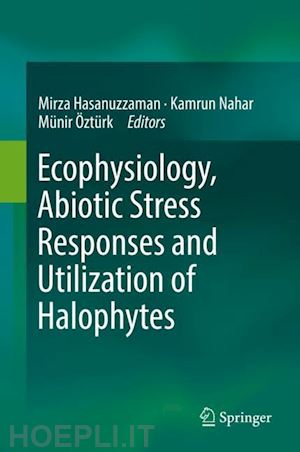

Questo prodotto usufruisce delle SPEDIZIONI GRATIS
selezionando l'opzione Corriere Veloce in fase di ordine.
Pagabile anche con Carta della cultura giovani e del merito, 18App Bonus Cultura e Carta del Docente
Chapter 1. Halophytes Responses and Tolerance to Abiotic Stresses.- Chapter 2. Behavior of Halophytes and their tolerance mechanism under different abiotic stresses.- Chapter 3. An Overview of the Germination Behaviour of Halophytes and Their Role in Food Security.- Chapter 4. Reactive Oxygen Species Production and Scavenging During Seed Germination of Halophytes.- Chapter 5. Halophyte Growth and Physiology under Metal Toxicity.- Chapter 6. Oxidative stress and antioxidant defense under metal toxicity in halophytes.- Chapter 7. Molecular mechanisms of osmotic stress recovery in extremophile plants: What can we learn from proteomics?.- Chapter 8. Halophytic Microbiome in Ameliorating the Stress.- Chapter 9. Economic utilization and potential of halophytes.- Chapter 10. Halophytes: prospective plants for future.- Chapter 11.Sustainable Use of Halophytic Taxa As Food and Fodder - An Important Genetic Resource in Southwest Asia.- Chapter 12. How Could Halophytes Provide a Sustainable Alternative to Achieve Food Security in Marginal Lands?.- Chapter 13. Halophytes – The Plants of Therapeutic Medicine.- Chapter 14. Halophyte species as a source of secondary metabolites with antioxidant activity.- Chapter 15. Phytoamelioration of the salt-affected soils through halophytes.- Chapter 16. Multidisciplinary studies on a pilot coastal desert modular farm growing Salicornia bigelovii in United Arab Emirates.- Chapter 17. Financial analysis of halophytes cultivation in a desert environment using different saline water resources for irrigation.- Chapter 18. Rhizophora Biomass of Mangrove Swamp Forests and its Utilization in Energy and Industrial Production: The Case of Malaysia.- Chapter 19. Halophytic Plant Diversity of Duzdag Mountain in Nakhchivan Autonomous Republic – Azerbaijan.
Dr. Mirza Hasanuzzaman is a Professor of Agronomy at Sher-e-Bangla Agricultural University in Dhaka, Bangladesh. He completed his Ph.D. on ‘Plant Stress Physiology and Antioxidant Metabolism’ at Ehime University, Japan with a scholarship from the Japanese government. Later, he completed his postdoctoral research at the Center of Molecular Biosciences, University of the Ryukyus, Japan, as a recipient of a Japan Society for the Promotion of Science (JSPS) postdoctoral fellowship. He was also awarded the Australian Government’s Endeavour Research Fellowship for postdoctoral research as an Adjunct Senior Researcher at the University of Tasmania, Australia. Dr. Hasanuzzaman’s current work is focused on the physiological and molecular mechanisms of environmental stress tolerance (salinity, drought, flood, and heavy metals/metalloids). He has published over 80 articles in peer-reviewed journals, edited six books and written 30 book chapters on important aspects of plant physiology,plant stress tolerance, and crop production. He is an editor and reviewer for more than 50 peer-reviewed international journals and was a recipient of the ‘Publons Peer Review Award 2017.’ He has been honored by various authorities for to his outstanding contributions to research and education, and received the World Academy of Science Young Scientist Award (2014).
Dr. Kamrun Nahar is an Associate Professor, Department of Agricultural Botany at Sher-e-Bangla Agricultural University, Dhaka, Bangladesh. She completed her Ph.D. on ‘Environmental Stress Physiology of Plants’ at Ehime University, Japan on a Japanese Government (MEXT) Scholarship in 2016. Dr. Nahar has been involved in research with field crops emphasizing stress physiology since 2006. She has completed several research projects funded by the Sher-e-Bangla Agricultural University Research System and the Ministry of Science and Technology (Bangladesh). Dr. Nahar has published numerous articles in peer-reviewed journals and books, including 50 articles and chapters related to plant physiology and environmental stresses with Springer, Elsevier, CRC Press, Wiley, etc. She is involved in editorial activities and serves as a reviewer for international journals. Further, she is an active member of over 20 professional societies.
Dr. Münir Öztürk (Ph.D.) completed his M.Sc. degree at Jammu & Kashmir University, Kashmir, and his Ph.D. & D.Sc. at Ege University Izmir, Turkey. Over the last 50 years, he has served in different positions at Ege University. Dr. Öztürk was elected as the “Vice President of the Islamic World Academy of Sciences” in 2017, and has received fellowships from the Alexander von Humboldt Society, Japanese Society for Promotion of Science, and National Science Foundation (USA). He is the Founding Director of the Centre for Environmental Studies at Ege University and has worked as a Consultant Fellow, Faculty of Forestry, Universiti Putra Malaysia, Malaysia and as Distinguished Visiting Scientist, ICCBS, Karachi University, Pakistan. His main fields of scientific interest are Plant Eco-Physiology; Medicinal and Aromatic Plants, Conservation of Plant Diversity; Biosaline Agriculture and Crops; Pollution and Biomonitoring. He has published 40 books, 50 book chapters, and more than 200 papers in prominent journals.











Il sito utilizza cookie ed altri strumenti di tracciamento che raccolgono informazioni dal dispositivo dell’utente. Oltre ai cookie tecnici ed analitici aggregati, strettamente necessari per il funzionamento di questo sito web, previo consenso dell’utente possono essere installati cookie di profilazione e marketing e cookie dei social media. Cliccando su “Accetto tutti i cookie” saranno attivate tutte le categorie di cookie. Per accettare solo deterninate categorie di cookie, cliccare invece su “Impostazioni cookie”. Chiudendo il banner o continuando a navigare saranno installati solo cookie tecnici. Per maggiori dettagli, consultare la Cookie Policy.